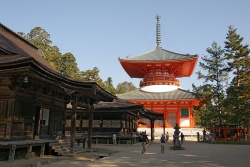Difference between revisions of "Mount Kōya"
(Created page with "thumb|250px|Danjogaran, the central point of Mt. Kōya. Mount Kōya (高野山 Kōya-san?) is the name of mountains in {{Wiki|Wakaya...") |
|||
| Line 1: | Line 1: | ||
[[File:Danjogaran Koyasan12n3200.jpg|thumb|250px|Danjogaran, the central point of Mt. Kōya.]] | [[File:Danjogaran Koyasan12n3200.jpg|thumb|250px|Danjogaran, the central point of Mt. Kōya.]] | ||
| − | Mount Kōya (高野山 Kōya-san?) is the [[name]] of mountains in {{Wiki|Wakayama Prefecture}} to the [[south]] of {{Wiki|Osaka}}. Also, Kōya-san is a modifying [[word]] for [[Kongōbu-ji]] ([[金剛峯寺]]). There is no one mountain officially called Kōya-san (高野山) in [[Japan]]. | + | [[Mount Kōya]] (高野山 Kōya-san?) is the [[name]] of mountains in {{Wiki|Wakayama Prefecture}} to the [[south]] of {{Wiki|Osaka}}. Also, Kōya-san is a modifying [[word]] for [[Kongōbu-ji]] ([[金剛峯寺]]). There is no one mountain officially called Kōya-san (高野山) in [[Japan]]. |
First settled in 819 by the [[monk]] [[Kūkai]], [[Mt. Kōya]] is primarily known as the [[world]] headquarters of the Kōyasan [[Shingon]] sect of [[Japanese Buddhism]]. Located in an 800 m high valley amid the eight peaks of the mountain (which was the [[reason]] this location was selected, in that the terrain is supposed to resemble a [[lotus]] plant), the original [[monastery]] has grown into the town of [[Wikipedia:Kōya, Wakayama|Kōya]], featuring a {{Wiki|university}} dedicated to [[religious]] studies and 120 [[temples]], many of which offer lodging to [[pilgrims]]. The mountain is home to the following famous sites: | First settled in 819 by the [[monk]] [[Kūkai]], [[Mt. Kōya]] is primarily known as the [[world]] headquarters of the Kōyasan [[Shingon]] sect of [[Japanese Buddhism]]. Located in an 800 m high valley amid the eight peaks of the mountain (which was the [[reason]] this location was selected, in that the terrain is supposed to resemble a [[lotus]] plant), the original [[monastery]] has grown into the town of [[Wikipedia:Kōya, Wakayama|Kōya]], featuring a {{Wiki|university}} dedicated to [[religious]] studies and 120 [[temples]], many of which offer lodging to [[pilgrims]]. The mountain is home to the following famous sites: | ||
| Line 7: | Line 7: | ||
* Danjogaran (壇上伽藍), a heartland of [[Mt. Kōya]]. | * Danjogaran (壇上伽藍), a heartland of [[Mt. Kōya]]. | ||
** Konpon Daitō (根本大塔), a [[pagoda]] that according to [[Shingon]] [[doctrine]] represents the central point of a [[mandala]] covering not only Mt. Kōya but all of [[Japan]] | ** Konpon Daitō (根本大塔), a [[pagoda]] that according to [[Shingon]] [[doctrine]] represents the central point of a [[mandala]] covering not only Mt. Kōya but all of [[Japan]] | ||
| − | * [[Kongōbu-ji]] (金剛峯寺), the head [[temple]] of the Kōyasan [[Shingon Buddhism]] | + | * [[Kongōbu-ji]] ([[金剛峯寺]]), the head [[temple]] of the Kōyasan [[Shingon Buddhism]] |
* {{Wiki|Kōyasan chōishi-michi}}, the [[traditional]] route up the mountain | * {{Wiki|Kōyasan chōishi-michi}}, the [[traditional]] route up the mountain | ||
* It also houses a replica of the {{Wiki|Nestorian stele}} | * It also houses a replica of the {{Wiki|Nestorian stele}} | ||
Revision as of 18:38, 11 November 2013
Mount Kōya (高野山 Kōya-san?) is the name of mountains in Wakayama Prefecture to the south of Osaka. Also, Kōya-san is a modifying word for Kongōbu-ji (金剛峯寺). There is no one mountain officially called Kōya-san (高野山) in Japan.
First settled in 819 by the monk Kūkai, Mt. Kōya is primarily known as the world headquarters of the Kōyasan Shingon sect of Japanese Buddhism. Located in an 800 m high valley amid the eight peaks of the mountain (which was the reason this location was selected, in that the terrain is supposed to resemble a lotus plant), the original monastery has grown into the town of Kōya, featuring a university dedicated to religious studies and 120 temples, many of which offer lodging to pilgrims. The mountain is home to the following famous sites:
- Okunoin (奥の院), the mausoleum of Kūkai, surrounded by an immense graveyard (the largest in Japan)
- Danjogaran (壇上伽藍), a heartland of Mt. Kōya.
- Kongōbu-ji (金剛峯寺), the head temple of the Kōyasan Shingon Buddhism
- Kōyasan chōishi-michi, the traditional route up the mountain
- It also houses a replica of the Nestorian stele
In 2004, UNESCO designated Mt. Kōya, along with two other locations on the Kii Peninsula, Yoshino and Omine; and Kumano Sanzan, as World Heritage Sites "Sacred Sites and Pilgrimage Routes in the Kii Mountain Range".
Access
The mountain is accessible primarily by the Nankai Electric Railway from Namba Station (in Osaka) to Gokurakubashi Station at the base of the mountain. A cable car from Gokurakubashi then whisks visitors to the top in 5 minutes. The entire trip takes about 1.5 hours on an express train or 2 hours by non-express. Local automobile traffic can be very heavy on weekends until well into the evening. On weekdays however, the mountain offers a pleasant drive followed by the excitement upon reaching the monasteries lining the summit. Many Buddhist monasteries on the mountain function as hotels for visitors providing traditional accommodation with an evening meal and breakfast.











